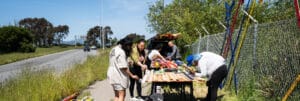On December 9, your favorite regional agencies and mine – the Metropolitan Transportation Commission and the Association of Bay Area Governments – released the long-anticipated answer to the question: how do the five different scenarios for Plan Bay Area* measure up to the 10 goals and targets we’ve set for ourselves as a region?
Simple math (five scenarios times 10 targets) gave us a clue that the answer would consist of a tidal wave of data (targets analysis, equity analysis, and powerpoint). You’re welcome to surf the wave yourself if you like, but just in case it’s a bit much, here’s a quick summary:
The good
- The scenarios that go furthest toward putting homes near job centers and the Bay Area’s main transit network (BART, Caltrain, etc.) generally do the best on most measures – reducing greenhouse gases, deaths from air pollution, injuries and fatalities from collisions, and overall driving, while STILL increasing walking, biking and transit use and protecting natural and agricultural lands. No surprise there – smart growth does the job.
- All the scenarios meet our 2020 greenhouse gas reduction target.
The bad
- While all scenarios show over 90% of new development in the existing urban footprint, close to 10% of development on greenfields is still disappointing. We can do better. The fact that Scenario 1 has 280,000 more homes than scenario 5 yet shows only 2% of development on greenfields (as opposed to 10% in scenario 5) proves it’s possible. What we need is political will to make it happen.
- No scenario meets the 2035 greenhouse gas reduction targets, even with good land-use plans and a strong emphasis on transit. It’s essential that the region start looking to other creative strategies, like Transportation Demand Management measures and equitable pricing policies, to get where we need to go for the climate.
The really bad
- In all scenarios, combined housing and transportation costs for low-income households take up over 75% of household income(!). In four scenarios, it’s over 80%. As a region, we need to get serious about addressing our housing affordability challenges. How would these results change if, for instance, the region passed a tax measure to fund affordable housing?What about if MTC quadrupled its investment in the Transit-Oriented Affordable Housing fund? We need to first study what it will take to improve the situation, and then make sure we actually implement those solutions.
The really interesting
- For most of the targets, there’s actually not a huge difference in the results among the scenarios – just a few percentage points. The one difference that really jumps out is with the “economic vitality” target. Gross Regional Product increases by over 130% in scenarios 1 and 2. But that result drops by almost 20 percentage points in scenarios 3, 4 and 5. Why the difference? Scenarios 1 and 2 actually plan to meet the region’s full projected housing need, while scenarios 3, 4 and 5 basically say, “oh, we’ll never be able to build that many homes; let’s just fall short of the goal.” The results mirror what we hear from the business community – CEOs of Bay Area companies have listed “the high cost of housing for employees” as the number one barrier to doing business here for the last seven years running. While the foreclosure crisis has decreased home values in certain areas, the most desirable neighborhoods in the region are still incredibly costly to live in. If we don’t meet our housing need, housing costs will continue to rise over the long term, and companies will start to look elsewhere to do business. These results show that reducing housing costs by increasing supply is an essential economic development strategy. It’s just simple supply and demand.
Now what?
Over the next several months, the regional agencies will be gathering feedback on the five scenarios with the goal of creating one “preferred scenario” for Plan Bay Area. The first step is a series of public workshops in January. The agencies hope to have a draft plan by March, with final adoption in May. Now is the time to make your voice heard on the future of growth and transportation for the region.
~ Stephanie Reyes, Policy Director
Greenbelt Alliance
* Plan Bay Area is the region’s plan for the next generation of growth and transportation. It’s a 25-year plan that will direct $200 billion of Federal, State, and Local funds to cities, transit, and roads around the Bay Area.




